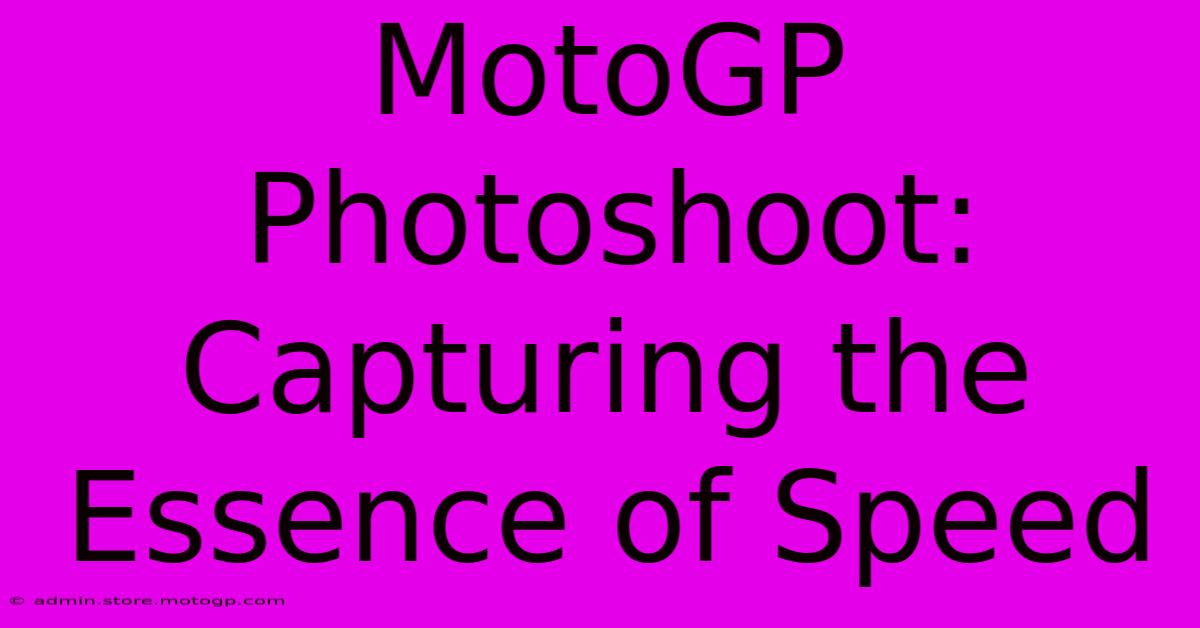MotoGP Photoshoot: Capturing The Essence Of Speed

Table of Contents
MotoGP Photoshoot: Capturing the Essence of Speed
MotoGP. The very name evokes images of screaming engines, blurred speed, and the breathtaking skill of the world's best motorcycle racers. But capturing the raw power and adrenaline-fueled intensity of a MotoGP photoshoot requires more than just pointing a camera. It's about understanding the sport, anticipating the action, and possessing a keen eye for detail. This article delves into the art and techniques behind a successful MotoGP photoshoot, exploring everything from equipment choices to post-processing strategies.
The Challenge of Capturing Speed
The biggest hurdle in MotoGP photography is, unsurprisingly, the speed itself. Riders often reach speeds exceeding 200 mph (320 km/h), making capturing sharp, clear images a significant challenge. Even the slightest camera shake can result in blurry shots, ruining what could have been an incredible image. This demands precision and the right tools.
Essential Equipment for a MotoGP Photoshoot:
-
High-Speed Cameras: A camera capable of shooting at a high frame rate (at least 10 frames per second, ideally much higher) is crucial. This allows you to capture multiple images of the action, increasing your chances of getting the perfect shot. Professional-grade DSLRs or mirrorless cameras are generally preferred.
-
Fast Lenses: A fast lens (with a wide maximum aperture, such as f/2.8 or faster) is essential for capturing sharp images in low-light conditions and achieving a shallow depth of field to isolate the rider from the background. Telephoto lenses are particularly useful for capturing close-up action shots.
-
Tripod or Monopod: While sometimes difficult to maneuver around a race track, a sturdy tripod or monopod is vital for minimizing camera shake, especially when shooting at slower shutter speeds. A monopod offers greater mobility.
-
Remote Shutter Release: A remote shutter release eliminates the risk of camera shake caused by pressing the shutter button manually.
-
Extra Memory Cards and Batteries: You'll be shooting a lot of images, so having plenty of spare memory cards and fully charged batteries is paramount. Don't risk missing that perfect shot due to technical limitations!
Beyond the Technical: Composition and Storytelling
While the equipment is vital, the artistry of a MotoGP photoshoot lies in the composition and storytelling. A great MotoGP photo isn't just a sharp image; it conveys emotion, action, and the spirit of the sport.
Techniques for Compelling MotoGP Photography:
-
Panning: This technique involves tracking the rider with your camera as they speed past, resulting in a sharp subject against a blurred background that emphasizes the speed and motion.
-
Leading Lines: Utilize natural leading lines, such as the track itself or barriers, to draw the viewer's eye towards the rider.
-
Perspective: Experiment with different angles and perspectives to create unique and dynamic images. Consider shooting from low angles to emphasize the power and height of the bikes.
-
Capturing Emotion: Don't just focus on the bikes; try to capture the emotions of the riders, their team members, and the fans. These moments add depth and human interest to your images.
Post-Processing for Perfection
Post-processing is a critical step in bringing your MotoGP photos to life. This involves enhancing colors, sharpening images, and correcting any minor flaws. However, resist over-processing. The goal is to enhance, not distort, the reality of the moment.
Key Post-Processing Steps:
-
Sharpening: Carefully sharpen images to enhance details without introducing artifacts.
-
Color Correction: Adjust white balance and color saturation to create a vibrant and realistic image.
-
Cropping and Composition Refinement: Use cropping to improve composition and eliminate distracting elements.
-
Noise Reduction: If shooting in low light, apply noise reduction to minimize graininess.
Conclusion: The Art of the MotoGP Photoshoot
Capturing the essence of speed in a MotoGP photoshoot is a challenging but incredibly rewarding experience. By combining technical proficiency with artistic vision, you can create powerful images that capture the raw energy and excitement of this thrilling sport. Remember the key elements: high-speed equipment, meticulous planning, strategic composition, and considered post-processing. Go forth and capture the roar!

Thank you for visiting our website wich cover about MotoGP Photoshoot: Capturing The Essence Of Speed. We hope the information provided has been useful to you. Feel free to contact us if you have any questions or need further assistance. See you next time and dont miss to bookmark.
Featured Posts
-
Circuit Of The Americas Parking Pass Your Ticket To Stress Free Race Day
Feb 19, 2025
-
Moto Gp Tracks Travel And Accommodation
Feb 19, 2025
-
Moto Gp Pictures For True Enthusiasts
Feb 19, 2025
-
Top Speed Moto Gp Bike Where Innovation Meets Performance
Feb 19, 2025
-
Hondas Moto Gp Innovations Changing The Game
Feb 19, 2025
